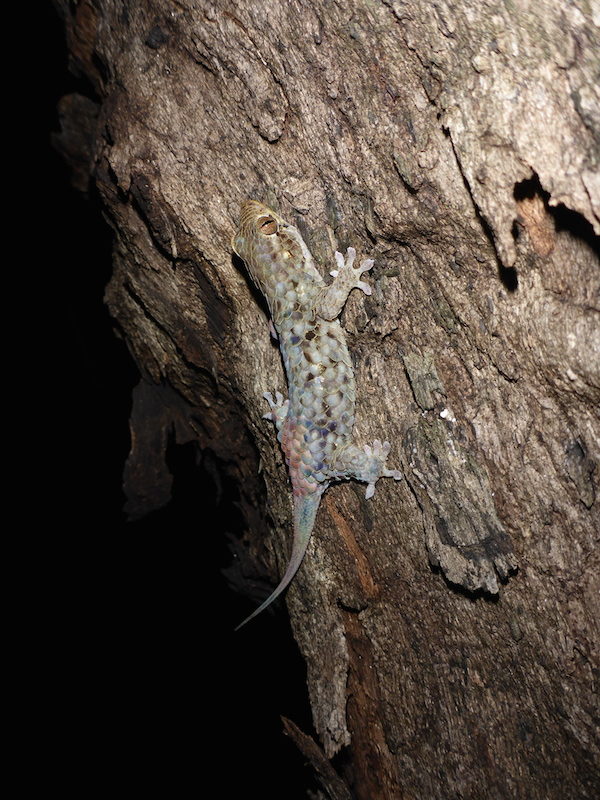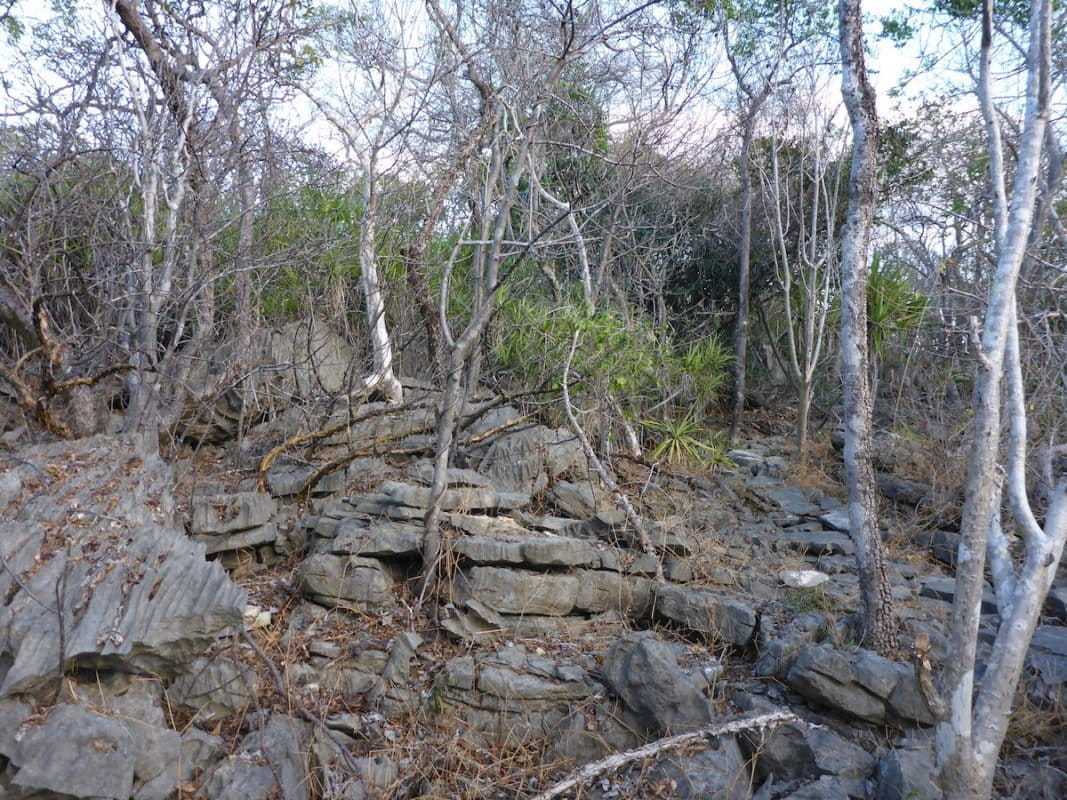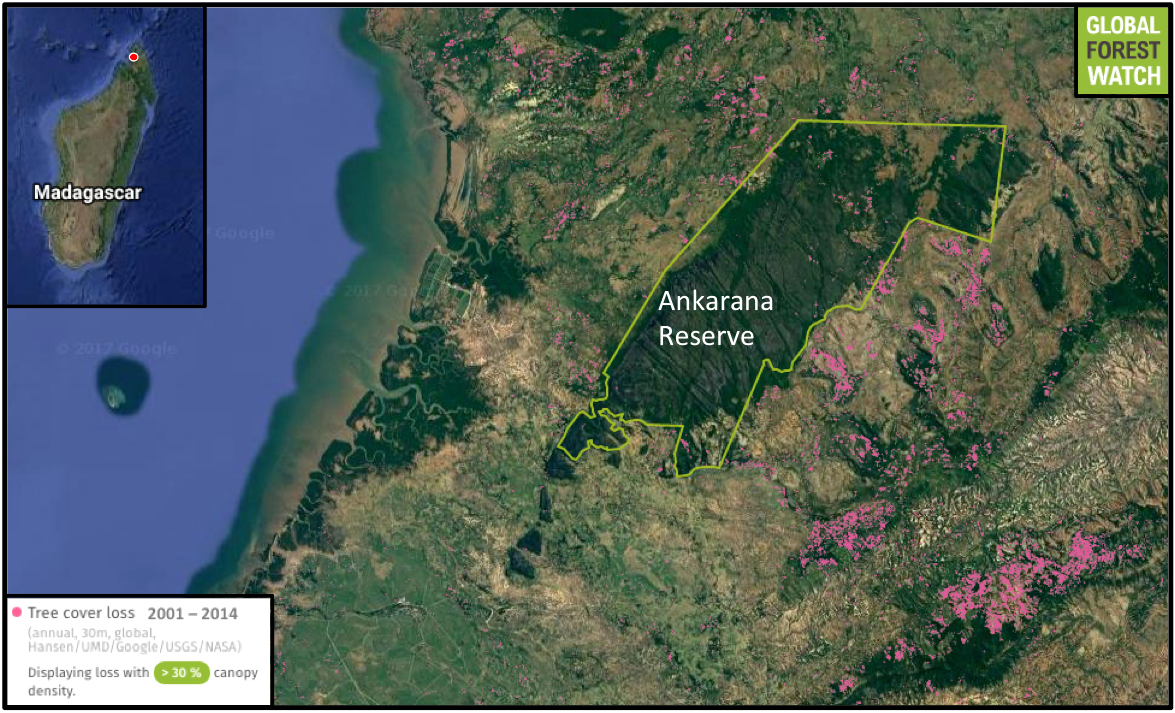- The new gecko was discovered in a reserve in northern Madagascar, a region threatened by deforestation.
- It is a new member of the “fish-scaled” gecko genus. All other species have large, shed-able scales, but G. megalepis has the largest of all.
- The geckos so easily shed their scales (along with other tissues) that researchers had to devise a novel way to capture them.
- The researchers think another five Geckolepis species may be awaiting discovery in Madagascar.
When at risk, go naked. At least that’s the defense strategy of a newly described species of gecko that can shed its scales in the face – or in this case, mouth – of danger.
Geckolepis megalepis is the latest of five species to be named in the so-called “fish-scaled” gecko genus – a group with a unique approach to predator evasion. When captured in the jaws of a predator, these geckos can shed their scales – along with a layer of skin, connective tissue, and fat – and literally slip away from harm, researchers say. The predator is left to dislodge a mouthful of scales while the denuded gecko seeks refuge, where its scales will regrow in a matter of weeks.
Debuted last week in the journal PeerJ, G. megalepis is a master of this trick. Indeed, scientists believe that the new gecko can shed and regenerate its scales more quickly than any of the other fish-scaled species.
“Nothing is adapted to do this as well as G. megalepis,” Mark Scherz, a doctoral student at Ludwig Maximilian University in Munich and lead author of the study, told Mongabay. “It’s really bizarre how much energy the gecko is willing to throw away to stay alive.”

“But losing scales is better than being food,” he adds.
The researchers believe that G. megalepis is so successful at shedding its armor due to the sheer size of its scales, which are much larger than those of any other gecko. As they write in the paper, “less force…should be required to remove a larger scale than a smaller one.” And when the scales do inevitably come off, they leave no scar – not even a drop of blood, the researchers say.
What makes fish-scaled geckos difficult for predators to capture makes them equally difficult for scientists to study. In fact, their scales tear away so easily that researchers have trouble collecting specimens with their armor intact, Scherz says.
But certainly not for lack of trying. In the late 1800s – when the first specimens of fish-scaled geckos were discovered – researchers tried carefully capturing the geckos with bundles of cotton wool, the paper states. However, even this approach resulted in scale loss.
Decades later, not much has changed – scientists are still laboring to capture these geckos with their scales intact. During an expedition to Ankarana Reserve in Madagascar – likely the one and only place where G. megalepis is found, according to the paper that describes the species – the researchers attempted to collect geckos by luring them into plastic bags.
“It’s always a bit of a struggle,” Scherz said. “Ideally, you have a second person there that holds a plastic bag underneath the gecko while you bat it off a tree. But every now and then you go for them by hand.”

According to Scherz, a gecko without scales is “practically useless” for science. That’s because the size, number, and pattern of scales usually helps researchers determine whether a lizard specimen is, in fact, a new species.
But even once scientists capture an individual with scales intact, identification remains a formidable challenge for members of Geckolepis, Scherz says. By adulthood, these geckos may have regrown their covering several times. Each time, the scales may look slightly different, rendering them unreliable as a species marker.
“They’re a nightmare to identify,” Scherz said in a press release, referring to species of the genus. “You have to think a bit outside the box with Geckolepis.”
That’s just what his team did.
In addition to applying more typical identification techniques, like measuring the size of the scales and analyzing the gecko’s DNA, Scherz used micro-CT scans – not unlike what you might get at the doctor’s office – to uncover morphological features that distinguish the new species from its closest kin. Micro-CT scans allow scientists to see slice-by-slice detail without ever having to, well, make a slice.
“We pulled in micro-CT in the hope that we would find solid characters that don’t get ruined every time you touch the animal, and it turned out to be the case,” Scherz said. “In the skeleton, we were able to go in and find complicated characters that support the assignment of the gecko as a different species.”
The identification of G. megalepis comes more than a century after the last fish-scaled gecko was described, the paper states. With this addition, there are now five species of fish-scaled geckos named. But the work is far from over. According to a previous study, there are likely five additional Geckolepis species that have yet to be named.

But what’s to a name? According to Scherz, a lot.
“There’s a lot of importance that comes with describing a new species,” he said. “[For example,] it’s very difficult to protect something that you don’t have a name for.”
Specifically, a species cannot be considered for The International Union for Conservation of Nature (IUCN) Red List of Threatened Species – the most widely cited catalogue of animals that are at risk to extinction – if it remains nameless. Red List labels, such as “Endangered” or “Vulnerable,” are critical to the protection of species, researchers say.
The authors recommend that G. megalepis be assigned to the IUCN category “Near Threatened,” which is reserved for a species that is “close to qualifying for or is likely to qualify for a threatened category in the near future.” In other words, a species that may soon be endangered.
“Soon” might be right around the corner. According to the study, illegal deforestation threatens the gecko’s habitat, which the researchers believe is a mere 182 square kilometers, total.
That’s right – the researchers say that G. megalepis is likely “microendemic,” meaning that the species is native and restricted to a very small region. In this case, that region is Ankarana Reserve, which lost around three square kilometers of tree cover since the turn of the century, according to data from the University of Maryland.

The national park in northern Madagascar is almost as unusual as its reptilian inhabitants. Ankarana was established around a topography known as “karst” – a landscape of canyons and crags formed from the erosion of limestone. And according to Scherz, it’s unlike anything around it.
“The habitat has very weird properties to it…it’s so different from everything around it,” he said. “And just by being inside the [Ankarana] formation, species are genetically isolated from everything outside.”
So-called “genetic isolation” is what happens when a population of a species can’t breed – or mix their genes – with other populations of the same species, often due to physical barriers. Compounded over thousands of years, “the power of isolation” can create distinct species – such as G. megalepis – Scherz says. Several other species, including the recently-discovered ghost snake, are also believed to be microendemic to Ankarana Reserve.
Microendemic species are especially susceptible to habitat loss. They simply have less of it to lose, researchers say. But despite prevailing threats to the reserve’s forests, G. megalepis appears to be at least locally healthy, Scherz says. And that’s because the species isn’t restricted to the trees.
“There’s always a threat of more and more people going into the park and taking down forests, but these geckos don’t just live on trees,” he said. “They also can climb on rocks, and so deforestation to them is going to be much less of a threat…”
So sure, they might be naked and even tailless – yes, their tails can come off, too – but G. megalepis is still kicking.
FEEDBACK: Use this form to send a message to the editor of this post. If you want to post a public comment, you can do that at the bottom of the page.
Citations:
Hansen, M. C., P. V. Potapov, R. Moore, M. Hancher, S. A. Turubanova, A. Tyukavina, D. Thau, S. V. Stehman, S. J. Goetz, T. R. Loveland, A. Kommareddy, A. Egorov, L. Chini, C. O. Justice, and J. R. G. Townshend. 2013. “High-Resolution Global Maps of 21st-Century Forest Cover Change.” Science 342 (15 November): 850–53. Data available on-line from:http://earthenginepartners.appspot.com/science-2013-global-forest. Accessed through Global Forest Watch on February 16, 2017. www.globalforestwatch.org
Scherz, M. D., Daza, J. D., Köhler, J., Vences, M., & Glaw, F. (2017). Off the scale: a new species of fish-scale gecko (Squamata: Gekkonidae: Geckolepis) with exceptionally large scales. PeerJ, 5, e2955.













